“In the annals of wartime savagery against the Jews, there was no group as sadistic as the Croatian Ustashi.”
IBM and the Holocaust by Edwin Black, © 2001
The Vatican aided and abetted the most sadistic murderers of WWII, the Croatian Ustashi and their leader Ante Pavelic. Following Hitler’s invasion of Yugoslavia, the Catholic Croats of the Ustaše rose up against the Jews and Orthodox Christian Serbs. The church saw the situation in Croatia as an opportunity to spread Catholicism in the Balkans. Pope Pius XII personally met with Ante Pavelic, and supported his efforts to eliminate Jews and Orthodox Serbs.
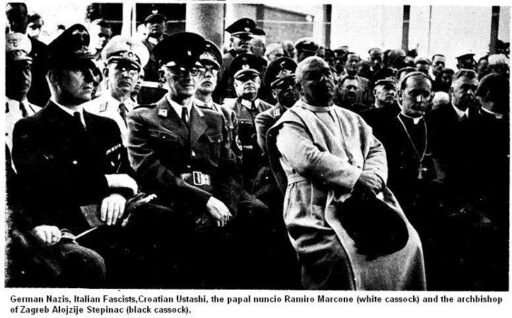
“Like the Nazis, the Ustaše/Ustashi deemed Jews, Romani, and Slavs to be sub-humans. They endorsed the claims from German racial theorists that Croats were not Slavs but a Germanic race. Their genocides against Serbs, against Jews, and against Romani were thus expressions of Nazi racial ideology”
Wikipedia
The Vatican’s support for the Catholic Croatian Ustashi was ongoing throughout the Holocaust. It began with a public endorsement by Eugenio Pacelli (Pope Pius XII) in 1939. Before the genocide of Serbs and Jews began, Pacelli colluded with the Archbishop of Croatia, Alojzije Stepinac and with the Croatian fascist leader Ante Pavelic. After the war, the Vatican helped hide Pavelic and his officers of the Ustasan Army. The church then arranged for the fugitives’ safe passage through their ratline to evade justice.
Catholic Run Ustashi
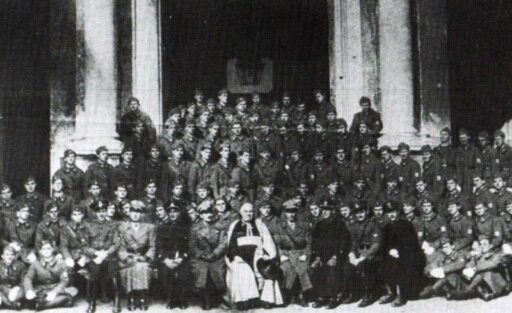
The Ustasa (“Rise Up”) was a murderous Croatian militia which came into power 80 years ago, in April 1941. It was dominated by priests and members of the Croatian Catholic Movement. The barbaric acts of Pavelic’s Ustashi were committed haphazardly with cruel violence. Records of atrocities show their weapons of choice were knives, axes, and meat hooks. The details of the torture and mutilation are so horrific; it is too sickening to report.
The Pope Knew

“Pacelli was better informed of the situation in Croatia than he was about any other area in Europe, outside of Italy, during the Second World War.”
Hitler’s Pope The Secret History of Pius XII by John Cornwell, ©1999
The Pope knew, in full detail, the acts committed against Jews and Orthodox Serbs in Croatia. Pacelli (Pius XII) had many channels in which to check and influence events in Croatia. His apostolic delegate, Ramiro Marcone, flew back and forth from Croatia to Rome frequently to keep the Pope up to date. The bishops, some of whom sat in the Croatian parliament, communicated freely with the Vatican regarding the conditions in Croatia.
Murderous Priests
The head of the Croatian Catholic church, was Archbishop Alojzije Stepinac. He also served as the Supreme Apostolic Vicar General of the Ustasan Army. He had direct access to the Pope, meeting him in February 1941. On April 28, 1941, the Archbishop wrote a pastoral letter which was read from all Catholic pulpits, calling on clergy and faithful to collaborate in the work of the leader. That very day, 250 Serbs were massacred at Bjelovan.
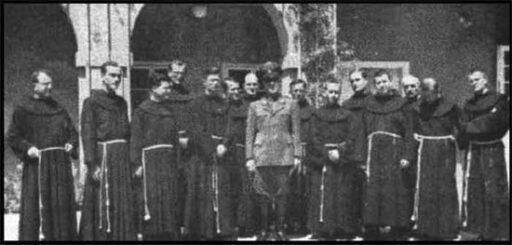
Catholic priests served in Pavelic’s private bodyguard, and served as Ustasan officers. Countless men, women and children were murdered at the hands of priests. Some of the concentration camps, were run by Franciscan monks.
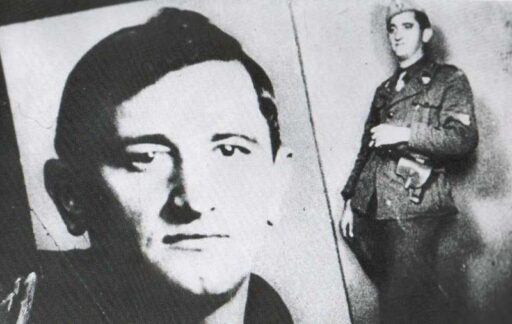
Roman Catholic priest who doubled as an officer in the Ustasan army. 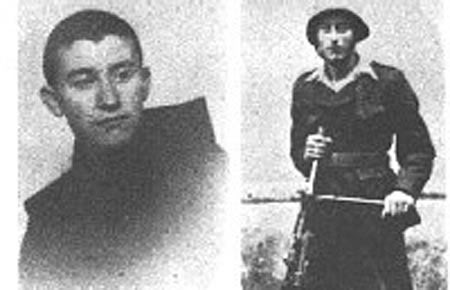
Franciscan monk in his priestly robe left, then pictured in his Ustashi uniform right. 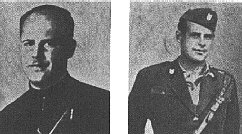
Franciscan monk, Miroslav Filipovic. Left, as a Roman Catholic priest. Right, in the Ustashi uniform. Filipovic was the Commandant of the Concentration Camp at Jasenovac where unspeakable atrocities were committed and many children were starved to death.
“Priests, invariably Franciscans, took a leading part in the massacre. Many went around routinely armed and performed their murderous acts with zeal… In September of 1941, an Italian reporter wrote of a Franciscan he had witnessed south of Banja Luka urging on a band of Ustashe with his crucifix.”
Hitler’s Pope
The Pope Meets Pavelic
The Vatican supported the efforts of the Croatian leader Ante Pavelic, a devout Catholic, who never missed daily Mass. Pavelic met Pope Pius XII at the Vatican on May 18, 1941.
“The racist and anti-Semitic measures were well known…by the Holy See and thus by Pacelli, at the point when he greeted Pavelic at the Vatican.”
Hitler’s Pope
Their meeting took place four days after the Glina massacre where hundreds of Serbs were locked in a church and butchered with axes and knives. The only survivors were two people who had documents proving their conversion to Catholicism and thus were allowed to leave the church before the massacre.
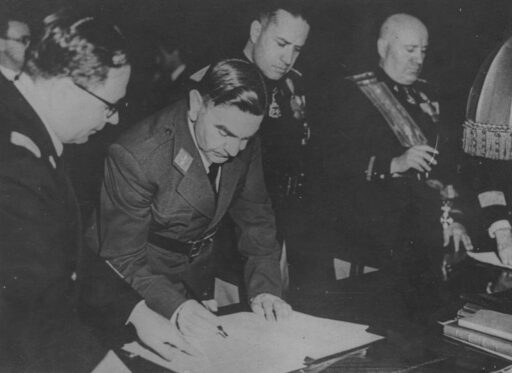
The same day Pavelic met with the Pope, the Ustase passed their version of the Nazi’s Nuremberg Laws. Pavelic declared fascist Croatia as Europe’s first fundamentalist Catholic nation. The independent State of Croatia was granted de facto recognition by the Holy See. The Vatican claims there were no minutes kept during the meeting between Pacelli and Pavelic.
“Whatever the conversation, Pavelic returned home and soon unleashed a bloodbath against the country’s Jews and Orthodox Christian Serbs…”
“[Pavelic] figured if he murdered half of all the Serbs, the survivors would either flee or convert to Catholicism. He intended to kill all the Jews.”
God’s Bankers by Gerald Posner, ©2015
A Plea to Intervene
Many people pleaded with the Pope to intervene and condemn the violence. However, he never spoke a word in opposition of the atrocities. A message urgently delivered to the Vatican came from a young man named Branko Bokun. He worked for the International Red Cross. His mission was to get to Rome and petition the Pope to put a stop to the Croatian massacres. He said,
“These Catholics are killing Serbs and Jews, because in their primitive minds they are convinced that it will please the Vatican. If the Vatican does not intervene immediately, the fight between Serbs and Croats will reach such proportions it will take centuries to die down.”
God’s Bankers
Of course, the Vatican did not intervene to stop the killings. Rather, they continued their support and encouragement of the Catholic Croats’ efforts. Their endorsement actually began before the war.
Church & State Relations
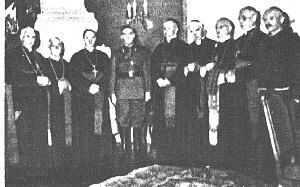
Two years before the first roundup and deportation occurred in Zagreb to a concentration camp in Danica, Pacelli had warmly endorsed Croat nationalism. In November 1939, a national pilgrimage came to Rome. The Croat primate, Archbishop Stepinac, represented the pilgrims and gave a speech in the Pope’s presence. In his response, Pacelli said,
“The hope of a better future seems to be smiling on you, a future in which the relations between Church and State in your country will be regulated in harmonious action to the advantage of both.”
Pope Pius XII in his speech to Catholic Croatians -Hitler’s Pope
Forced Conversions
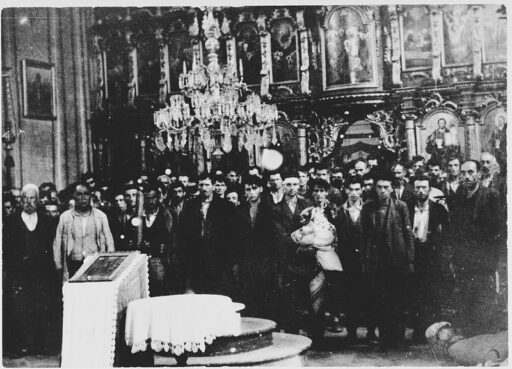
Orthodox Serbs were forced to convert to Catholicism to avoid torture and death. There were frequent BBC broadcasts on the situation in Croatia. One, which aired on February 16, 1942, was typical. The broadcast reported of the forced conversions taking place.
“The worst atrocities are being committed in the environs of the archbishop of Zagreb [Stepinac]. The blood of brothers is flowing in streams. The Orthodox are being forcibly converted to Catholicism and we do not hear the archbishop’s voice preaching revolt. Instead it is reported that he is taking part in Nazi and Fascist parades.”
Hitler’s Pope
There is evidence that the Vatican knew of the forced conversions by the summer of 1941. Yet, in July 1941 the Pope greeted a hundred members of the Croatian police force headed by the Zagreb chief of police. On February 6, 1942, he gave an audience for an Ustashe youth group visiting Rome. He had greeted another representative of Ustashe youth in December of the same year.
The Vatican’s support for the Ustashi continued after the war as well. The church benefitted from the elimination of opposing religions in their efforts to create a purely Catholic nation. The Vatican also greatly profited financially. The plunder from war-torn Croatia was secretly moved into the coffers of the church.
Blood Money
Before Ante Pavelic and his henchman fled blood-soaked Croatia, they looted upwards of 350 million Swiss francs of gold from banks in Zagreb. About 150 million of the plunder was seized by British forces at the Swiss-Austrian border. The other 200 million (equivalent to 530 million in 2014 US dollars), entered the Vatican for “safe-keeping.”
Ten truckloads packed with gold traveled from Switzerland to Rome where it was “unloaded at the College of San Girolamo degli Illrici, the Croatian seminary, only a mile from the Vatican. The convoy reportedly arrived with Vatican license plates, accompanied by some men wearing stolen British military uniforms and others dressed as priests.” -God’s Bankers
Meet Ustasan Croatian priest, Krunoslav Draganovic. During the war, he was in charge of the Ustasan commission dedicated to the forced conversion of Serbs. In 1943, Pavelic sent him to Rome to be secretary of San Giralamo.
Dragonovic received the truckloads of the Ustasan plunder when they arrived at the seminary. He then turned the Croatian gold and other loot over to the Vatican Bank (the IOR). The blood money was classified by the IOR as “a contribution from a religious organization.”
“The Vatican appointed Dragonovic as the Apostolic Visitor for Pontifical Assistance for Croatians. That made him a Vatican official who reported directly to the Secretary of State’s office.”
God’s Bankers
Draganovic was the highest-ranking Ustasan cleric in Rome and liaison to the Vatican. He was placed in charge of assisting Croatians, meaning the Catholic Croats who were now fugitives fleeing Croatia to evade justice. The Croatian leader, Ante Pavelic found safe-haven at San Giralamo, during his hide-out in Rome. Pavelic was under the personal protection of the Vatican appointed Pontifical Assistant for Croatians.
Ratline for Pavelic and his henchmen
When Yugoslavia was taken under Communist control, it demanded the extradition of all Ustasan leaders. The church provided countless fugitives with false travel documents and tickets by boat to foreign countries to escape trial.
Pavelic evaded a two-year manhunt by hiding in Rome. To avoid detection, he moved between several Vatican owned properties, such as seminaries and basilicas. Most of the time, he was at San Giralamo, under Draganovic’s protection. Eventually it was concluded he was hiding within Vatican City. In 1947, the Vatican sent Pavelic through its ratline to Argentina.
Pius XII, known for his silence during the war, “expressed public anger over the convictions of half a dozen Croatian Catholic priests by the Yugoslav War Crimes Commission.” Bishop Stepinac was convicted. While he was in prison, the Pope made Stepinac a cardinal. John Paul II beatified him in 1998, the first step toward sainthood.
In 1943, Pacelli “expressed his pleasure at the personal letter he had received from our Poglavnik [Pavelic].” Pacelli said he was “disappointed that, in spite of everything, no one wants to acknowledge the one, real and principle enemy of Europe; no true communal military crusade against Bolshevism has been initiated.”
Hitler’s Pope
Let this be a lesson for the future. As it was in Croatia, the relations between Church and State are “regulated in harmonious action to the advantage of both.” When a government does the Pope’s bidding, there is no limit to the evil it will commit.
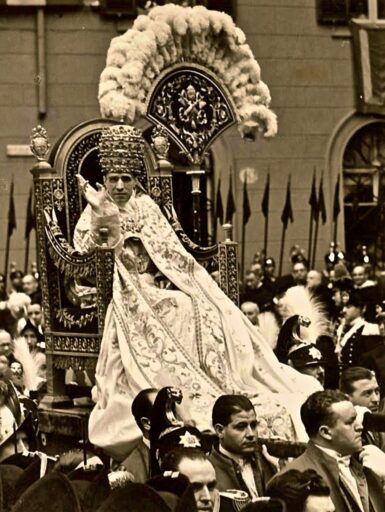
“Because you have spoiled many nations, all the remnant of the people shall spoil you; because of men’s blood, and for the violence of the land, of the city, and of all that dwell therein. Woe to him that covets an evil covetousness to his house, that he may set his nest on high, that he may be delivered from the power of evil! You have consulted shame to your house by cutting off many people and have sinned against your own soul…Woe to him that builds a city with blood, and establishes a city by iniquity.”
Habakkuk 2:8-12
“Excommunicated – Marshal Josip Broz Tito (1946) and all Catholics who participated in the trial of Archbishop Aloysius Stepinac of Zagreb and the trial of Archbishop József Mindszenty of Hungary, which included most of the jury members.”
https://en.wikipedia.org/wiki/List_of_people_excommunicated_by_the_Catholic_Church